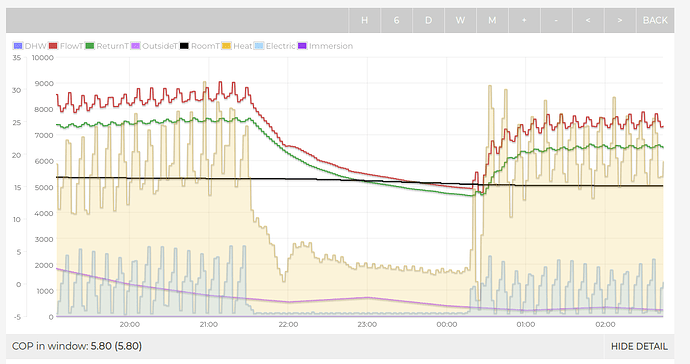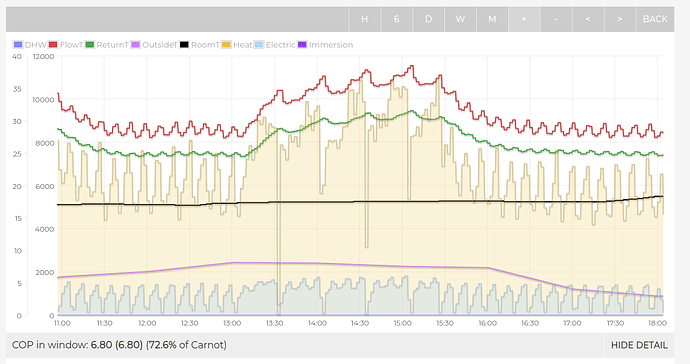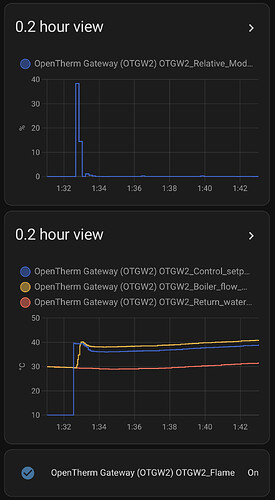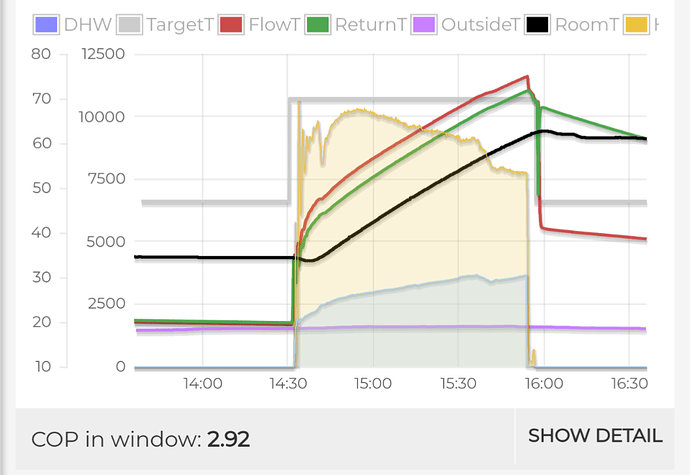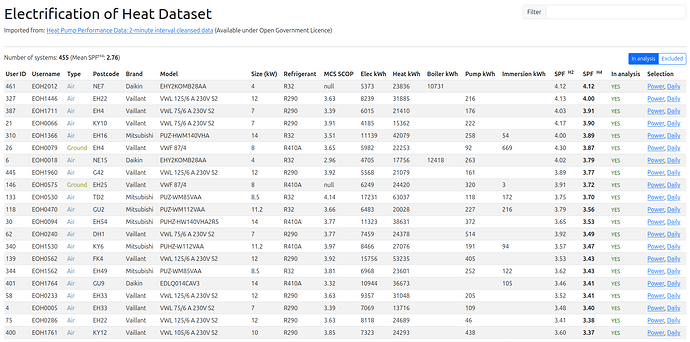Generally it’s whichever period has a continuous period of decent data that spans a year, so it varies from system to system.
Thanks so much for importing this data set and scrutinising it. For me, it just serves to reinforce the notion that manufacturers should be obliged to develop control systems that continuously adapt and optimise themselves
I think machine learning facilities are well overdue.
This ![]()
I can’t understand why a heat pump continues banging its head against the brick wall of short cycling. Why can’t it learn that what it is doing is not productive and temporarily change some parameters?
If I spot my Daikin heat pump short cycling on a warm day I reduce the Madoka set point by 1 or 2 degrees and that stops the cycling. But why does it take my intervention?
Maybe not ![]() Looks like it has some fairly sizable temperature sensor offset error…
Looks like it has some fairly sizable temperature sensor offset error…
Then I wondered if it could be temperature sensors on the wrong side of a volumiser but I think that’s unlikely as it hits a unrealistically high % carnot here. This one could do with higher resolution data really to see what’s happening…
Thank you for sharing this information. It’s really interesting and gives of all us invaluable insights into heat pump world.
The average performance on HeatpumpMonitor.org for 48 systems is currently running at an SPF H4 of 4.0. Enough to give a saving of 17% vs gas.
If we are trying to showcase and compare performance between well-installed heat pumps and gas boilers, then it also makes sense to compare it to a better-than-average gas boiler.
My boiler runs at over 93% efficiency [floor area = 185 and heat loss = 5). It’s the thermostat that makes the huge difference which is open source. Boiler can now (thanks to recent development efforts) run at 0% relative modulation all the time, where control setpoint is set to flow_temperature - 2, shortly after each duty cycle starts. My average flow and return temperatures are only little bit above those similar heat pumps (no radiators were changed). Boiler is oversized but the thermostat manages the low load with 3 duty cycles max per hour.
Most boilers are not configured to be as efficient, but, a well configured one runs at competitive costs to a well installed heat pump.
Nevertheless, heat pump technology is the only right direction and I’m going to install one as soon as my boiler breaks down for good ![]()
It’s a shame we lost two decades without having decent thermostat controls as standard for these boilers, but let’s focus on the future.
Thanks again!
Tomas has also been experimenting with optimising a high efficiency gas boiler. Check out his YouTube channel for more info.
That’s probably not it, as I am doing my Legionella cycles manually by setting the setpoint to 70°C (Vaillant’s builtin Legionella cycle always uses my backup heater which is inefficient). This is how that looks (with tank temperature as room temperature):
I never reach 70°C storage temperature because the heat pump just turns off at some point. This is temperature driven, as it turns of sooner in warm weather, so likely related to some sensor in the outdoor unit. I can, a bit paradoxically, reach higher DHW temperatures in winter than in summer.
In the example time window I linked, the flow temperature reaches 60°C very quickly and stays high for a long time. It’s almost as if there is very little energy actually being drawn. Over the whole cycle, it’s just 6 kWh. For a once-a-day DHW cycle going to 70°C that’s quite little. Also those blips with COP 1 or lower after the first longer cycle are weird.
This goes to show that actually logging the DHW temperature along with the other parameters would be very useful.
How do those temperature probes just slip out? Mine is actually screwed in.
The max flow temperature of R290 is 75C, but in practice 70C seems to be about the real word maximum. In a typical DHW tank a 70C flow temperature into thr coil will result in around 65C tank temperature, so a backup or immersion heater will be required to hit 70C. However, 70C is far in excess of what’s required for legionella.
Many DHW tanks just have a smooth pocket for the DHW sensor, the installer should use a cable tie or some other means to secure. This is somtimes missed.
Hope ok if I post the link to this on the OVO forum which had a private group for the 250 or so heat pumps in the South East, one of which is mine.
Yes that’s fine, just mention that the website is work in progress so far. I will get a proper URL, make it mobile friendly and make a whole load of other improvements to make the site more useable, filtering, search, access to the wider range of design related contextual information collected by the project. What with Christmas I need to avoid spending all my time on this as tempting as it is! ![]()
There will likely be some down time later as I upgrade the server/VM as it will need a bit more disk space to import all of the data.
I also wonder what the most constructive way to engage is around this. I remember listening to Paul Spences podcast on BetaTeach where he makes the case that rather than heaping blame related to issues like this we could do well to understand that all involved are learning about a new form of heating, getting comfortable with low temp heat etc. That we should find ways to engage with others in constructive learning. Ideally we find a way of working with the Electrification of Heat project team and others involved to improve things for the future.
On the flip side sometimes a rant is a good wake up call. I did enjoy Damon Blakemore’s rant on LinkedIn where he expressed his anger at SPF H4 of 2.8-2.9 being celebrated as a success!
I certainly wouldn’t lay blame on anyone for anything here. This is probably the first time ever that anyone has such a comprehensive overview of heatpump performance in situ. Everyone can only learn from it. That said, I also enjoy a good rant and there are a lot of rant-worthy things in those datasets.
My personal takeaway is that heat pumps are actually harder to get right than I initially thought. They are not “fire-and-forget” like condensing gas boilers, where a proper low-temperature configuration translates to a measly 15% savings. Proper operation is crucial to longevity and low running costs. I think a “managed” approach is required for most people where the installation is properly monitored and adjusted remotely so it runs reliably.
I did wonder about whether this forum could contribute to/edit the Wikipedia entry on Heat Pumps (and the derivative pages like ASHPs), perhaps including more guidance on heat pump optimisation, but the fact that the average HP purchaser is unlikely to look at Wikipedia (or this forum) suggests that the effort might be wasted.
We’d also be up against the big brother syndrome - most folk don’t like being told what to do (even if it’s in their own interest), and are likely to resist any “compulsory advice” ![]() .
.
That’s unfortunately true - which is why I think a “managed” approach might make even more sense. You’re selling people a warm house and don’t have them worry about what to do.
It would be interesting to see average performance by brand. Just looking through the results it looks as if there is one brand that stands out with the most poorly performing units and one with the most efficient units.
Personally I am one where my unit sits around 2.54. I installed the monitoring kit as the installer refused to accept the system was oversized and performing poorly. I have since reported the install to both MCS and NAPIT and hoping the evidence results in the installer being forced to pay for the replacement of the unit to one that matches the heat loss of the property. Fingers crossed.
That depends on the heights of the thermostat and how low the coil is in the tank. Without logging of temperature at the lowest point in the tank, it not possible to run a legionella cyle at the minimal biological required temperature.
Thankfully the cold water inlet on most domestic tanks mixes up the water so in real life we don’t get pockets of never heated water in the bottom.
(without looking at the raw data myself)
How does “integrating instantaneous temperatures/flowrates/power at 2 minute interval” compare with the cumulative energy/volume from the meters? (start and end value) I wonder if there is there a meaningful difference at that integration interval vs 10 seconds for heat pumps.
I suspect many of the ultra low / high COPs aren’t actually that low. Just metering errors and a data collection solution that doesn’t provide for flagging them. (e.g. air in meter; or flat out not installed correctly) Tricky to “clean up” datasets without the full picture of how the meters were fitted and the data collected and “pre cleaned” though!
We once asked DESNZ if the EOH trail could add a tag for (a) the main contractor (e.g. E.ON, Ovo) and (b) the installer (e.g. MCS registration). In my experience the correlation between “the degree to which employees have any pride / shame,” their employer, and the end result is as least as strong as it is with hardware. (e.g. it takes a special kind of moral compass to make the decision not to revisit an installation when the data that you are receiving shows a COP under 1)
I wonder if more eyeballs on the data might prompt DESNZ to divulge this information; or at least group the installations by anonymised installer. By grouping in this manner it would then possible to look at the technology independently of installer error / quantify the potential for investing in tech vs investing in installation standards etc. One conclusion might be "holy moly; we ought to make monitoring for 2 year defect period mandatory if providing taxpayer subsidy; as it appears the installation standard makes an enormous difference to lifecycle cost. Averaging it all out (as government tends to do) and modelling “typical” sCOP as the mean sCOP (including all installation/operation shortcomings) tends to obfuscate all the potential IMO.
Thanks @Marko_Cosic
The trial data only provides cumulative energy figures (in Wh) and system temperatures. I’ve made use of this to calculate power values based on the difference in the energy readings every 120s. This works well for populating the Emoncms dashboards.
I would like to implement the same check that we have implemented for HeatpumpMonitor that ensures that simultaneous electric and heat measurements need to be in place at all times. That way we can check and flag periods where a meter is offline for whatever reason.
I would also like to implement an automated flag based on % carnot COP, if that goes out of realistic range for more than a set period of time that should register a flag. This would catch things like the heat from a gas boiler being included as heat pump output.
I do think visual inspection of the data is key, it looks like this was a missing component of the project so far given some of the examples above. Though perhaps limitations in software visualisation made it difficult to see what we are seeing?
As gas boilers efficiency depends on return temperature rather then flow temperature, just having a very oversized radator in the livingroom with a fast acting promotional TRV will improve efficiency. Likewise a simple TPI thermostat can give good results even if used as a On/Off switch with a high flow temperature.
Heatpumps depends on getting every room correct, including when the use of the rooms changes for each resident so can’t be predicted by the designer.
Happy to say that we now have both a filter box option (copied from @Timbones’s is implementation for HeatpumpMonitor) and I’ve separated out the systems that the EoH team excluded from their SPF analysis onto a separate page.
All the systems will also be loaded, completing shortly (automated background process, thankfully)
https://eoh.heatpumpmonitor.org/
Would be nice to see reallife data for Octopus Cosy 6 systems as:
- Are sold with a direct long term relationship between the heatpump manufacturer and end user
- They have data collection from all of them.
- They can easily update the software on both the heatpump and controller/thermostat.
- They designed the package after lots of experience with installing/maintaining heatpumps in UK into real homes with existing none optimal plumbing/radators and none expert users.
Likewise for systems with a Homely thermostat as they get realtime usage data and can easily update their software for all their clients.
